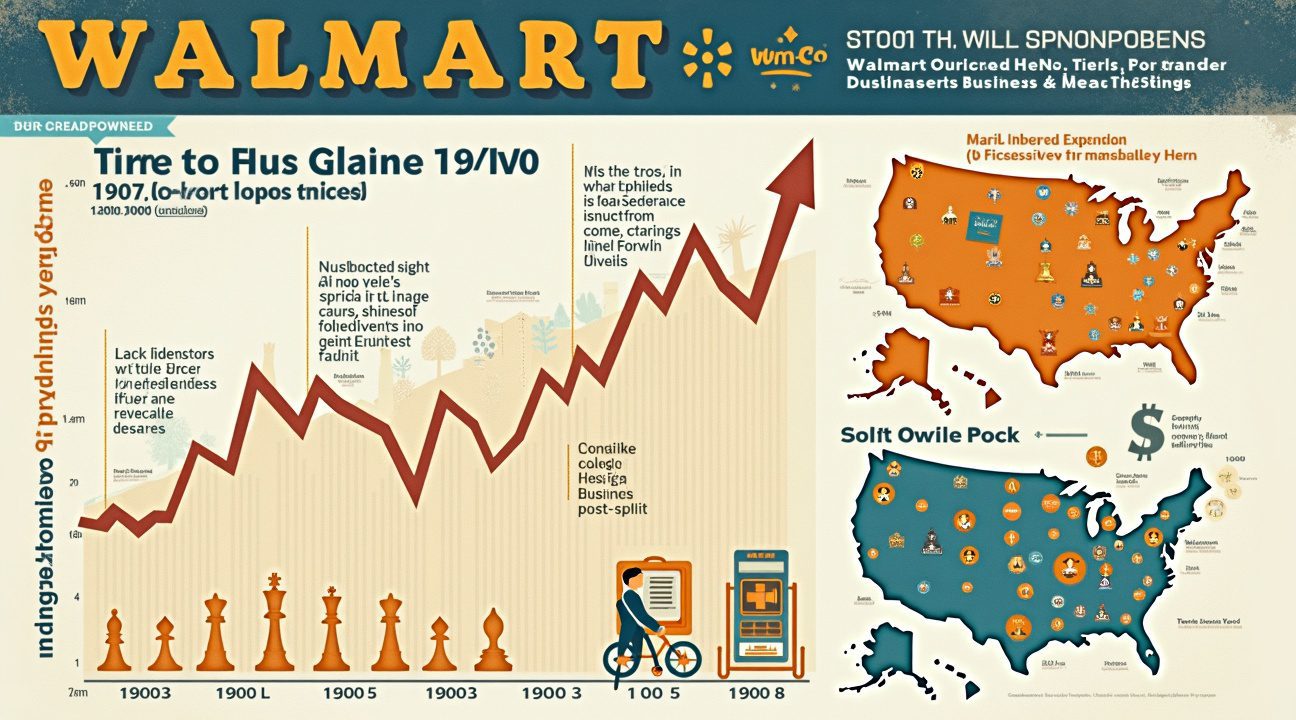Walmart hasn’t executed a stock split since February 1999, creating an unprecedented 25-year drought that contrasts sharply with the company’s earlier pattern of 11 splits between 1971 and 1999. This extended pause reflects fundamental changes in the investment landscape, including the rise of fractional share trading and Walmart’s strategic shift focused on dividend-centered returns rather than share price accessibility measures.
Key Takeaways
- Walmart completed 11 stock splits from 1971 to 1999, all at 2-for-1 ratios, transforming 100 original shares into 204,800 shares for early investors.
- The company’s 25-year split drought since 1999 represents a strategic departure from its historical approach, even as shares have climbed above $160.
- Modern fractional share investing and commission-free trading have eliminated traditional accessibility barriers that historically drove stock split decisions.
- Sam Walton’s “always low prices” philosophy originally extended to stock accessibility, with splits structured to keep shares affordable for everyday investors.
- Walmart now prioritizes consistent dividend growth and operational stability over stock splits, appealing to income-focused investors seeking reliable quarterly returns.
While stock splits were once considered essential to maintain share accessibility, the landscape has evolved. With modern investing platforms offering fractional shares and zero-commission trades, companies like Walmart no longer face the same pressure to split their stock. This shift represents a larger trend in investor priorities, where steady dividend performance and robust business fundamentals outweigh the cosmetic benefits of more affordable share prices.
Walmart’s 25-Year Stock Split Drought: Why the Retail Giant Stopped Dividing Shares
Walmart hasn’t conducted a stock split since February 1999, marking an unprecedented 25-year period without share divisions for the retail behemoth. This extended drought stands in stark contrast to the company’s earlier history of regular stock splits throughout the 1980s and 1990s.
During this quarter-century pause, Walmart’s share price has climbed dramatically. As of mid-2024, the stock consistently trades above $160 per share, representing substantial appreciation from its split-adjusted value in the late 1990s. This price level would have traditionally triggered split considerations for many companies, yet Walmart has remained steadfast in its position.
Divergent Paths from Tech Giants
The contrast becomes particularly striking when comparing Walmart’s approach to other major corporations. Tech giants like Apple and Microsoft have embraced stock splits as regular shareholder-friendly measures during the same timeframe. Apple alone has conducted multiple splits since 1999, including a 4-for-1 split as recently as 2020. Microsoft has also maintained its splitting tradition with actions in 2003 and several others.
Walmart’s departure from this practice suggests a fundamental shift in corporate philosophy regarding share accessibility and market positioning.
Modern Investment Landscape Changes
Several factors help explain Walmart’s extended split hiatus. The rise of fractional share investing has fundamentally altered the investment landscape, removing traditional barriers that high share prices once created. Individual investors can now purchase portions of expensive stocks through most major brokers, effectively eliminating the accessibility argument that historically drove stock splits.
Key developments that have reduced split pressure include:
- Widespread availability of fractional share trading platforms
- Commission-free trading offered by major brokers
- Dollar-cost averaging programs that automatically invest fixed amounts
- Robo-advisors that handle fractional allocations seamlessly
Instead of pursuing stock splits, Walmart has focused on delivering consistent dividend growth and operational stability. This strategy appeals to income-focused investors who prioritize reliable quarterly payments over share price manipulation tactics. The company has maintained a steady dividend policy, with regular increases that provide tangible value to shareholders without the administrative complexity of share divisions.
The retail giant’s approach reflects confidence in its long-term value proposition. By avoiding splits, Walmart signals that it views its current share price as appropriate relative to the company’s fundamentals and growth prospects. This stance aligns with a more mature corporate perspective that emphasizes sustainable business performance over short-term trading dynamics.
Recent speculation about a potential Walmart stock split has emerged as the share price continues climbing, yet management has shown no indication of departing from its established approach.
The Complete Chronicle: Walmart’s 11 Stock Splits From 1971 to 1999
I count 11 stock splits in Walmart’s history between 1971 and 1999, marking an era of extraordinary growth for the retail giant. After going public in 1970 with shares trading around $16.50, the company began its impressive stock splitting journey just one year later.
The first split occurred in August 1971 with a 2-for-1 ratio, setting a pattern that would define the company’s approach for nearly three decades. March 1972 brought another 2-for-1 split, followed by a third identical split in February 1975. These early splits reflected the company’s rapid expansion during the 1970s as Sam Walton’s discount retail concept gained momentum across America.
The Acceleration Years: 1980s Growth Trajectory
The 1980s marked an acceleration in Walmart’s splitting frequency. August 1980 delivered another 2-for-1 split, followed by June 1982 and June 1983 splits at identical ratios. The company maintained this yearly June timing for three consecutive years with another split in June 1985, then repeated the pattern in June 1987.
During this period, Walmart transformed from a regional discount retailer into a national powerhouse. Each split made shares more accessible to everyday investors while reflecting the stock’s appreciation driven by the company’s aggressive expansion strategy.
The Final Phase: 1990s Consolidation
The 1990s brought the final three splits in Walmart’s history. June 1990 continued the established pattern with another 2-for-1 split. April 1993 marked a slight deviation from the June timing but maintained the consistent 2-for-1 ratio that characterized all previous splits.
February 1999 represented Walmart’s final stock split, completing the sequence at 11 total splits. By this point, the share price had reached approximately $90, representing substantial appreciation from the original $16.50 IPO price.
I observe that every single split maintained the 2-for-1 ratio, demonstrating remarkable consistency in the company’s approach. This pattern differs significantly from more recent corporate actions, such as Walmart’s 3-for-1 stock split discussions that emerged decades later. The frequency of these splits — averaging one every 2.5 years during the peak period — illustrates the rapid stock price appreciation that characterized Walmart’s golden growth era.
Since 1999, Walmart hasn’t executed any additional stock splits, marking a shift in the company’s capital allocation strategy as it matured from a high-growth retailer into a established dividend-paying stock.
How Early Walmart Investors Became Millionaires Through Split Magic
Stock splits played a pivotal role in creating extraordinary wealth for Walmart’s early investors. Each time the company executed a split, shareholders saw their share count double while the individual share price was cut in half. This process made Walmart stock more accessible to a broader range of investors without changing the fundamental value of existing holdings.
The mathematics behind these splits reveal the true magic for early believers. An investor who purchased 100 shares of Walmart in 1970 would have witnessed an incredible transformation over the following decades. Through a series of strategic splits, those original 100 shares multiplied into 204,800 shares by 1999. This dramatic increase in share count, combined with steady price appreciation, generated life-changing returns for patient investors.
The Compounding Effect of Multiple Splits
The compounding nature of Walmart’s splits created wealth through two distinct mechanisms:
- Each split increased the total number of shares in an investor’s portfolio.
- The reduced share price attracted new buyers, often driving demand and supporting continued price growth.
These factors worked together to amplify returns far beyond what traditional stock appreciation alone could have achieved.
Smart investors recognized that Walmart’s split strategy reflected the company’s confidence in its growth trajectory. Management consistently chose to split shares when prices became too high for average investors, demonstrating their commitment to maintaining broad shareholder participation.
Stock splits don’t alter a company’s market capitalization or change the proportional ownership percentages of existing shareholders. However, they significantly improve stock liquidity by lowering the entry price for new investors. This increased accessibility often leads to higher trading volumes and can support long-term price appreciation.
The recent 3-for-1 split announcement continues this tradition of making shares more affordable. While modern investors might not see the same explosive growth that early shareholders experienced, the principles remain the same. Companies that consistently split their stock typically demonstrate strong operational performance and management confidence.
Early Walmart investors who held through multiple stock splits understood that patience and persistence could generate extraordinary returns. Their success stories illustrate how split magic, combined with a company’s fundamental growth, can create millionaires from modest initial investments.

Sam Walton’s Philosophy: Making Walmart Stock Accessible to Everyone
Sam Walton’s famous “always low prices” philosophy extended far beyond Walmart’s retail operations and directly influenced the company’s approach to stock splits throughout its history. I believe this commitment to accessibility became a cornerstone of Walmart’s equity strategy, ensuring that everyday investors could participate in the company’s growth story just as easily as institutional players.
The retail giant consistently executed stock splits when share prices climbed to levels that might discourage average investors from purchasing shares. This strategic approach reflected Walton’s deep understanding that broad-based ownership would create a more stable and committed shareholder base. Rather than allowing share prices to reach prohibitive heights, Walmart management proactively reduced barriers to entry through regular splitting activity.
Strategic Timing and Market Signals
Walmart’s timing for stock splits typically coincided with periods of strong operational performance and ambitious expansion plans. The company’s pattern of splits sent clear signals to the market about management’s confidence in sustained growth prospects. These actions proved particularly effective during Walmart’s rapid expansion decades, when the retailer was aggressively opening new stores and entering new markets.
Market participants generally interpreted these splits as positive indicators of future performance. The Walmart stock split by 3-for-1 pattern became a familiar occurrence that investors learned to associate with continued growth momentum. Each split effectively communicated management’s belief that the company’s trajectory would continue upward, justifying the increased share count through proportional value appreciation.
The accessibility factor proved crucial for Walmart’s employee stock ownership programs as well. By keeping individual share prices manageable, the company enabled thousands of associates to build meaningful equity positions over time. This approach aligned perfectly with Walton’s vision of shared prosperity and employee ownership participation.
Liquidity enhancement represented another key benefit of Walmart’s splitting strategy. Lower share prices typically attracted more retail investors and increased daily trading volumes. This improved liquidity made it easier for all shareholders to buy or sell positions without significantly impacting market prices. The enhanced trading activity also reduced bid-ask spreads, creating additional value for investors of all sizes.
Historical data shows that Walmart consistently executed splits before share prices reached levels that might seem excessive to retail investors. This proactive approach prevented the stock from developing an exclusionary reputation among smaller investors. The company’s commitment to maintaining reasonable share prices demonstrated genuine concern for broad-based ownership rather than catering exclusively to institutional investors.
The philosophy extended to dividend accessibility as well. When combined with regular splits, Walmart’s dividend payments became more approachable for investors building positions through dollar-cost averaging strategies. Smaller share prices enabled investors to purchase whole shares more easily, maximizing the efficiency of dividend reinvestment programs.
Throughout the 1990s and early 2000s, Walmart’s 3-for-1 stock split approach became synonymous with the company’s growth story. Investors learned to recognize these events as milestones marking significant value creation periods. The consistency of this approach built trust and predictability that many shareholders valued highly.
Modern market dynamics have somewhat reduced the perceived necessity of stock splits, as fractional share trading has made expensive stocks more accessible. However, Walmart’s historical commitment to splits reflected a deeper understanding of investor psychology and market dynamics. The company recognized that psychological barriers to investment could be just as significant as financial ones.
The success of Walmart stock splits for 3-for-1 ratios demonstrated the effectiveness of this accessibility-focused approach. Each split created opportunities for new investors to enter while existing shareholders benefited from improved liquidity and continued growth potential. This balanced approach exemplified how operational philosophy could successfully translate into capital markets strategy.
Sam Walton’s vision of making quality accessible to everyone found perfect expression in Walmart’s stock split history, creating lasting value for generations of investors while maintaining the democratic principles that defined the company’s retail success.

Strategic Share Price Management During Walmart’s Growth Era
Walmart’s approach to stock splits during its expansion years reveals a calculated strategy aimed at maintaining investor accessibility while signaling strong growth prospects. When the retail giant went public in 1970 at approximately $16.50 per share, management established a pattern of share price management that would define the company’s relationship with investors for decades.
Price Thresholds and Accessibility Strategy
The company’s executives consistently executed splits when share prices reached levels that might discourage average investors from purchasing stock. This practice demonstrates management’s commitment to keeping shares within reach of individual investors, not just institutional buyers. Throughout the 1970s, 1980s, and 1990s, Walmart maintained this accessibility-focused approach as the stock price climbed from its modest IPO level to around $90 by the time of its final split in 1999.
Stock splits served a dual purpose during this period. They reduced the nominal share price while simultaneously increasing the total number of shares outstanding, making the stock more affordable for smaller investors. This strategy proved particularly effective during Walmart’s aggressive expansion phase, when the company was opening new stores at a rapid pace and needed broad investor support to fuel growth.
Market Signals and Growth Confidence
Financial markets typically interpret stock splits as strong indicators of management confidence in future performance. Walmart’s consistent splitting pattern during its growth decades reinforced this perception among investors and analysts. Each split announcement essentially communicated that leadership expected continued appreciation in share value, making current prices attractive entry points for new investors.
The timing of these splits often coincided with periods of significant operational expansion. As Walmart opened new stores across the United States and refined its supply chain operations, the stock split decisions reflected management’s belief that the company’s growth trajectory would continue pushing share prices higher. This created a positive feedback loop where splits attracted new investors, providing additional capital for expansion, which in turn supported higher valuations.
During the 1980s and 1990s, Walmart’s splitting strategy became part of its broader investor relations approach. The company understood that maintaining an accessible share price helped build a diverse shareholder base, including individual investors who were also customers of Walmart stores. This alignment between customer base and investor base created additional stakeholder loyalty and support for the company’s expansion plans.
The psychological impact of splits shouldn’t be underestimated in Walmart’s strategic considerations. Lower nominal share prices after splits often generated increased trading volume and media attention, creating momentum that supported continued price appreciation. This phenomenon helped Walmart maintain visibility in financial markets during critical growth periods when the company needed access to capital markets for expansion funding.
Management’s consistent execution of splits also established predictable expectations among investors. As share prices approached certain thresholds, market participants began anticipating potential split announcements, which often created upward pressure on the stock price. This predictability became part of Walmart’s investment appeal during the growth era.
The strategic timing of these corporate actions demonstrates sophisticated understanding of market dynamics. Rather than arbitrary price targets, Walmart’s splits appeared to consider broader market conditions, company performance metrics, and investor sentiment. This thoughtful approach helped maximize the positive impact of each split announcement.
The journey from $16.50 at IPO to $90 at the final split represents approximately 445% growth over 29 years, not accounting for the multiple splits that occurred during this period. When factoring in the splits, the actual appreciation for original investors was substantially higher, validating management’s confidence signals embedded in each splitting decision.
This era of active share price management through splits concluded in 1999, marking the end of a strategic approach that had successfully supported Walmart’s transformation from a regional retailer to a global commerce leader. The historical pattern of splits established during these decades created lasting expectations among investors about the company’s approach to share price accessibility and growth communication.

Walmart’s Modern Investment Appeal Without Stock Splits
Walmart maintains its prestigious position as a cornerstone of the Dow Jones Industrial Average and ranks among the world’s largest companies by market capitalization. The retail giant’s investment appeal extends far beyond traditional stock manipulation tactics, demonstrating that solid fundamentals often outweigh cosmetic financial maneuvers.
The company’s commitment to shareholder value manifests through consistent dividend payouts and reliable capital returns. Walmart’s dividend policy has become increasingly attractive to income-focused investors, particularly during periods of market volatility. This steady approach to dividend growth creates a compelling investment thesis that doesn’t rely on stock price accessibility.
Fractional Share Investing Changes the Game
Modern investment platforms have fundamentally altered how investors access high-priced stocks. Several factors contribute to this shift:
- Fractional share investing allows purchases of partial stock units
- Commission-free trading platforms eliminate cost barriers
- Dollar-cost averaging strategies work effectively with any stock price
- Robo-advisors automatically diversify portfolios regardless of individual stock prices
These technological advances have reduced the pressure on companies to conduct stock splits purely for accessibility reasons. Walmart’s stock split history reflects this changing landscape, with fewer splits occurring as fractional investing gained popularity.
Companies like Walmart now focus more on operational performance and shareholder returns rather than stock price psychology. The retail giant’s strategy emphasizes long-term value creation through dividend growth and share buyback programs. This approach appeals to institutional investors and individual shareholders who prioritize steady returns over short-term price movements.
Walmart’s financial stability has attracted investors seeking defensive positions during economic uncertainty. The company’s consistent revenue streams from its retail operations provide a foundation for reliable dividend payments. This stability becomes particularly valuable during market downturns when investors gravitate toward established companies with predictable cash flows.
The absence of recent stock splits hasn’t diminished institutional interest in Walmart shares. Large investment firms continue allocating significant portions of their portfolios to the company based on its fundamental strength rather than stock price considerations. Professional fund managers recognize that stock splits don’t create value and focus instead on operational metrics and growth prospects.
Walmart’s capital allocation strategy prioritizes returning cash to shareholders through multiple channels. The company balances dividend payments with strategic investments in e-commerce infrastructure and supply chain improvements. This comprehensive approach to shareholder value creation reduces the perceived need for stock splits as a mechanism to attract investors.
Recent market trends show that investors increasingly value companies that demonstrate financial discipline over those that engage in financial engineering. Walmart’s conservative approach to stock splits aligns with this preference for substance over style. The company’s leadership appears to recognize that sustainable business growth creates more lasting value than periodic stock price adjustments.
The retail sector’s evolution has reinforced Walmart’s position as a stable investment option. While many traditional retailers struggle with digital transformation, Walmart has successfully integrated online and offline operations. This operational success provides a stronger foundation for investor confidence than any stock split could achieve.
Current market conditions favor companies with strong balance sheets and reliable cash generation. Walmart’s ability to maintain dividend growth during challenging economic periods demonstrates the type of financial strength that attracts long-term investors. This focus on fundamental performance explains why stock splits have become less central to the company’s investor relations strategy.
The modern investment landscape rewards companies that prioritize operational excellence and consistent shareholder returns. Walmart’s approach reflects this reality, emphasizing sustainable business practices over short-term stock price management. This strategy has proven effective in maintaining investor interest despite the extended period without stock splits.

Sources:
Walmart Investors Relations: “Stock Split FAQ”
Investopedia: “A History of Stock Splits: Walmart Case Study”
The Motley Fool: “Walmart Stock Split: What Investors Should Know”
Yahoo Finance: “Walmart’s Stock Split History and Impact on Shareholders”
The Wall Street Journal: “Why Walmart Stopped Splitting its Shares”


